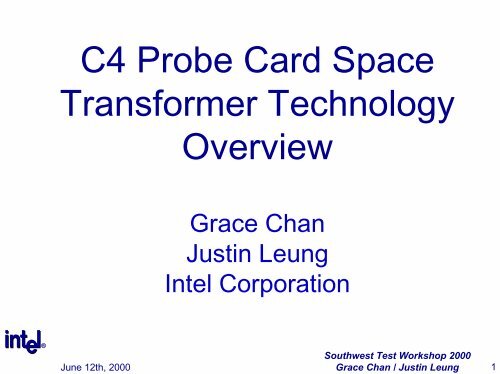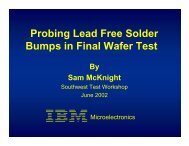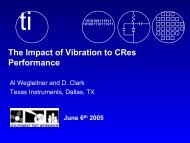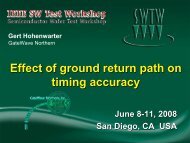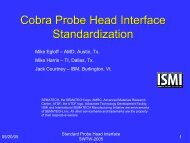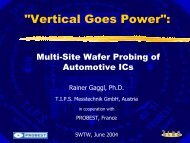C4 Probe Card Space Transformer Technology Overview
C4 Probe Card Space Transformer Technology Overview
C4 Probe Card Space Transformer Technology Overview
You also want an ePaper? Increase the reach of your titles
YUMPU automatically turns print PDFs into web optimized ePapers that Google loves.
<strong>C4</strong> <strong>Probe</strong> <strong>Card</strong> <strong>Space</strong><br />
<strong>Transformer</strong> <strong>Technology</strong><br />
<strong>Overview</strong><br />
Grace Chan<br />
Justin Leung<br />
Intel Corporation<br />
®<br />
June 12th, 2000<br />
Southwest Test Workshop 2000<br />
Grace Chan / Justin Leung<br />
1
Outline<br />
! <strong>C4</strong> <strong>Probe</strong> <strong>Card</strong> <strong>Space</strong> <strong>Transformer</strong><br />
<strong>Overview</strong><br />
! Multi-layer Ceramic <strong>Space</strong> <strong>Transformer</strong>s<br />
! Future <strong>Space</strong> <strong>Transformer</strong> Technologies<br />
®<br />
June 12th, 2000<br />
Southwest Test Workshop 2000<br />
Grace Chan / Justin Leung<br />
2
<strong>C4</strong> <strong>Probe</strong> <strong>Card</strong> Cross-section<br />
interposer (BGA, PGA, etc..)<br />
pogos<br />
PCB<br />
decoupling caps<br />
ST<br />
decoupling caps<br />
3 Major<br />
Components of a<br />
<strong>Probe</strong> <strong>Card</strong><br />
<strong>C4</strong> <strong>Probe</strong>s<br />
®<br />
June 12th, 2000<br />
Southwest Test Workshop 2000<br />
Grace Chan / Justin Leung<br />
3
<strong>C4</strong> <strong>Space</strong> <strong>Transformer</strong> Structure<br />
“LGA side”<br />
ST caps<br />
Interposer<br />
(BGA, PGA,etc..)<br />
I/O trace routing<br />
<strong>C4</strong> probe pads<br />
Pwr/Gnd Planes<br />
“<strong>C4</strong> side”<br />
®<br />
June 12th, 2000<br />
Southwest Test Workshop 2000<br />
Grace Chan / Justin Leung<br />
4
<strong>Space</strong> <strong>Transformer</strong> Key<br />
Functions<br />
! PCB pad to <strong>C4</strong> bump pitch reduction<br />
! Power delivery<br />
! I/O routing<br />
! <strong>Probe</strong> card structural integrity<br />
®<br />
June 12th, 2000<br />
Southwest Test Workshop 2000<br />
Grace Chan / Justin Leung<br />
5
Microprocessor<br />
Performance Trends<br />
YEAR 1999 2000 2001 2002 2003 2004 2005<br />
TECHNOLOGY NODE 180 nm 130 nm 100nm<br />
<strong>C4</strong> Area Array bump pitch (µm) 200 200 200 200 200 200 150<br />
Chip size (mm 2 ) 450 450 450 509 567 595 622<br />
Projected bump count 11250 11250 11250 12725 14175 14875 27644<br />
Clock Frequency (MHz) 1200 1321 1454 1600 1724 1857 2000<br />
Power (W) 90 100 115 130 140 150 160<br />
Core Supply Voltage (V) 1.8 1.8 1.8 1.5 1.5 1.2 1.2<br />
Maximum Current (A) 50 56 64 87 93 125 133<br />
Data abstracted from International <strong>Technology</strong><br />
Roadmap for Semiconductors, 1999 Edition<br />
®<br />
June 12th, 2000<br />
Southwest Test Workshop 2000<br />
Grace Chan / Justin Leung<br />
6
<strong>Space</strong> <strong>Transformer</strong> Critical<br />
Physical Parameters<br />
Minimum Via Diameter and Pitch<br />
Minimum Line and <strong>Space</strong> Dimensions<br />
Dielectric Thickness (100 - 250 µm)<br />
Relative Dielectric Permittivity (ε r = 3.0 - 9.5)<br />
Metal Sheet Resistance (3 - 10 mΩ/sq)<br />
Power/Ground Perforation (0 - 50%)<br />
Coefficient of Thermal Expansion (3 to 70 ppm/ o C)<br />
Flexural Strength (80 - 400 MPa)<br />
Thermal Conductivity (0.2 - 200 W/m-K)<br />
®<br />
June 12th, 2000<br />
Southwest Test Workshop 2000<br />
Grace Chan / Justin Leung<br />
7
<strong>Space</strong> <strong>Transformer</strong> Electrical<br />
Performance Illustration<br />
ST caps<br />
Interposer<br />
Loop inductance<br />
Tester<br />
Power Supply<br />
Plane resistance<br />
®<br />
June 12th, 2000<br />
Large<br />
<strong>Probe</strong> R & L<br />
Southwest Test Workshop 2000<br />
Grace Chan / Justin Leung<br />
8
Package and <strong>Space</strong><br />
<strong>Transformer</strong> Comparison<br />
Package<br />
<strong>Space</strong> <strong>Transformer</strong><br />
I/O Route all traces Only route subset of I/O's<br />
PWR/GND All bumps <strong>Probe</strong> subset of bumps<br />
Number of<br />
layers<br />
On-Pkg<br />
Capacitors<br />
Cost restriction<br />
Cost restriction<br />
Minimize via inductance<br />
Maximize # Caps<br />
Force Insertion <strong>Probe</strong> forces<br />
Operating<br />
Temperature<br />
Designed for external<br />
temperature compatibility<br />
Designed for sort<br />
Reliability Thermal shock tests Mechanical touchdowns<br />
Connections <strong>C4</strong> bumps <strong>C4</strong> probes (high R & L)<br />
®<br />
June 12th, 2000<br />
Southwest Test Workshop 2000<br />
Grace Chan / Justin Leung<br />
9
<strong>Space</strong> <strong>Transformer</strong> -<br />
Multi-layer Ceramic<br />
! High Temperature Co-fired Ceramic (co-firing<br />
temperature ~1600 o C)<br />
! Alumina - 90%+ Al 2 O 3 and 10%- Glass; AlN, BeO,<br />
Mullite (3Al 2 O 3 •2SiO 2 )<br />
! W/Mo Metallization (High melting temperature )<br />
Resistivity = 5.0 µΩ-cm<br />
! Typical dielectric thickness range: 150 - 200 µm<br />
! Relative Dielectric permittivity ε r = 9.6<br />
! CTE = 6.7 ppm o C -1<br />
! Layer stack can exceed 30 layers<br />
®<br />
June 12th, 2000<br />
Southwest Test Workshop 2000<br />
Grace Chan / Justin Leung<br />
10
MLC Manufacturing<br />
Process Flow<br />
Courtesy of Kyocera<br />
®<br />
June 12th, 2000<br />
Southwest Test Workshop 2000<br />
Grace Chan / Justin Leung<br />
11
Multi-layer Ceramic<br />
Cross-Section<br />
Courtesy of NTK<br />
®<br />
June 12th, 2000<br />
Southwest Test Workshop 2000<br />
Grace Chan / Justin Leung<br />
12
MLC <strong>Technology</strong><br />
limitations<br />
• High metal resistivity<br />
• High dielectric permittivity<br />
• Via manufacturing process<br />
• Line patterning process<br />
• Dimensional tolerance<br />
• Throughput time<br />
®<br />
June 12th, 2000<br />
Southwest Test Workshop 2000<br />
Grace Chan / Justin Leung<br />
13
Future <strong>Space</strong> <strong>Transformer</strong><br />
Technologies<br />
! MLC with Multiple-layer Thin Film (MLC-<br />
MTF)<br />
! AlN Substrate with Multiple-layer Thin<br />
Film<br />
! Organic Build-up<br />
! Glass Ceramic<br />
®<br />
June 12th, 2000<br />
Southwest Test Workshop 2000<br />
Grace Chan / Justin Leung<br />
14
MLC with Multi-layer Thin<br />
Film<br />
! Thin-film build-up occurs after co-firing<br />
process<br />
! Polyimide (PI) thin film build-up on Al 2 O 3<br />
Ceramic by spin coating<br />
! Cu metallization on PI thin film by<br />
photopatterning<br />
! Fine line width and via dimensions<br />
®<br />
June 12th, 2000<br />
Southwest Test Workshop 2000<br />
Grace Chan / Justin Leung<br />
15
MLC-MTF Illustration<br />
Courtesy of NTK<br />
®<br />
June 12th, 2000<br />
Southwest Test Workshop 2000<br />
Grace Chan / Justin Leung<br />
16
AlN Substrate with MTF<br />
! Polyimide (PI) thin film build-up on AlN<br />
substrate<br />
! Cu metallization on PI thin film by<br />
photopatterning<br />
! No internal layers exist in AlN; PTH<br />
(Plated Through Hole) vias<br />
! Fine line width and via dimensions<br />
! Excellent heat dissipation<br />
®<br />
June 12th, 2000<br />
Southwest Test Workshop 2000<br />
Grace Chan / Justin Leung<br />
17
AlN with MTF Illustration<br />
Al-N<br />
w/ PTH<br />
®<br />
June 12th, 2000<br />
Southwest Test Workshop 2000<br />
Grace Chan / Justin Leung<br />
18
Organic Build-up Solution<br />
! Organic build-up on both sides of a core<br />
! Cu metallization; line pattern defined by<br />
photopatterning<br />
! Via formation by laser drilling or<br />
photolithography at build-up; PTH through<br />
core<br />
! Fine line width and via dimensions<br />
®<br />
June 12th, 2000<br />
Southwest Test Workshop 2000<br />
Grace Chan / Justin Leung<br />
19
Organic Build-up Illustration<br />
Courtesy of NTK<br />
®<br />
June 12th, 2000<br />
Southwest Test Workshop 2000<br />
Grace Chan / Justin Leung<br />
20
Glass Ceramic<br />
! Low Temperature Co-fired Ceramic with<br />
Cu metallization<br />
! Manufacturing flow very similar to MLC<br />
(HTCC)<br />
! Lower co-firing temperature (
Glass Ceramic Illustration<br />
Courtesy of NTK<br />
®<br />
June 12th, 2000<br />
Southwest Test Workshop 2000<br />
Grace Chan / Justin Leung<br />
22
<strong>Technology</strong> Comparison<br />
MLC-MTF AlN-MTF Organic Build-up Glass Ceramic<br />
Conductor<br />
Dielectric Constant<br />
Power Delivery<br />
Routing Capability<br />
Structural Integrity<br />
Thermal Conductivity<br />
CTE mismatch with<br />
PCB<br />
Throughput Time<br />
W/Mo; Cu for TF W in PTH; Cu for TF Cu Cu<br />
9.2-9.6 8.8 3.6 5.3<br />
Fair Poor Fair Good<br />
Good Good Good Fair<br />
Fair Fair Poor Good<br />
Good Excellent Poor Fair<br />
Fair Fair Poor Good<br />
Poor Fair Good Fair<br />
®<br />
June 12th, 2000<br />
Southwest Test Workshop 2000<br />
Grace Chan / Justin Leung<br />
23
Summary<br />
! A space transformer is a major component of a probe<br />
card. It provides pitch reduction, high routing density<br />
and localized mid-frequency decoupling.<br />
! A space transformer and a microprocessor package<br />
have very different design driving factors. An optimal<br />
package design may not be a good space transformer.<br />
! With accelerating microprocessor performance, future<br />
space transformer technologies are necessary. MLC-<br />
MTF, AlN-MTF, Organic build-up, and glass ceramic are<br />
all contenders to be the next generation technology.<br />
®<br />
June 12th, 2000<br />
Southwest Test Workshop 2000<br />
Grace Chan / Justin Leung<br />
24


